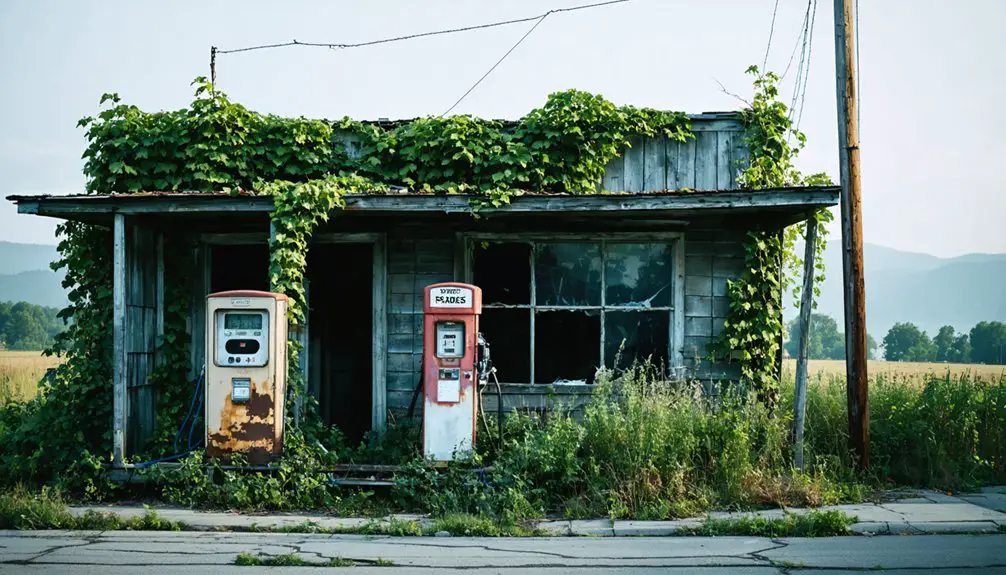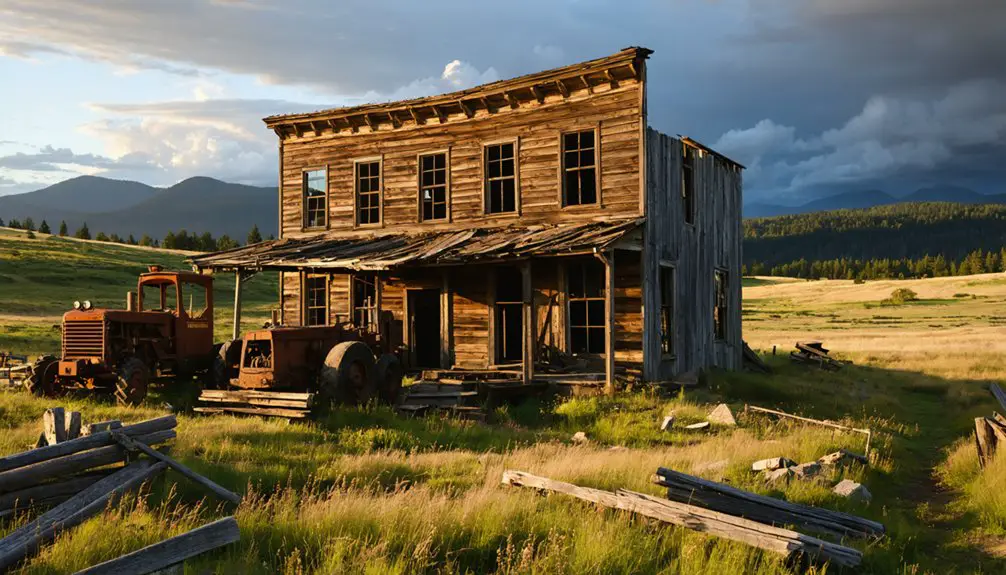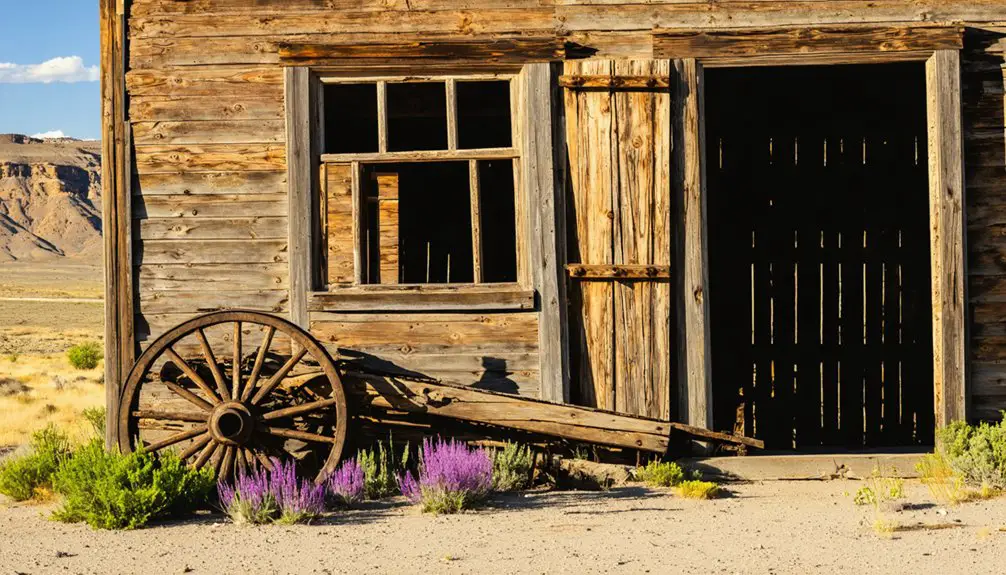You’ll find Auburn’s ghost town remains in eastern Oregon, where Griffin Creek’s 1861 gold discovery sparked the region’s first major settlement. By 1862, this boomtown became Baker County’s seat, boasting 6,000 residents and the area’s first post office. After depleting its placer gold deposits, Auburn’s population plummeted to just 150 by late 1864. The dramatic rise and fall of this frontier mining town holds fascinating secrets within its abandoned landscape.
Key Takeaways
- Auburn was established in 1862 following a major gold discovery, becoming eastern Oregon’s first significant mining settlement with 6,000 residents.
- The town served as Baker County’s first seat and housed northeastern Oregon’s first post office during its brief peak.
- Mining activity centered around placer gold deposits, which began depleting by 1864, triggering the town’s rapid decline.
- Population plummeted from 6,000 to just 150 residents between 1863-1864 as miners abandoned the area for new opportunities.
- Today, Auburn exists only as a ghost town, with its swift rise and fall exemplifying the boom-and-bust cycle of mining settlements.
The Discovery of Gold and Town’s Birth
While gold had been discovered throughout the American West in the 1850s, Auburn’s story began in October 1861 when prospectors struck gold along Griffin Creek in Oregon’s Blue Mountains.
D. Littlefield and a small group led the discovery of rich placers in the spring of 1862, setting the stage for Auburn’s explosive growth.
This discovery, intertwined with the legendary “Blue Bucket” tale of a lost guide named Adams, sparked an immediate rush of miners to the region.
By June 1862, the rapidly growing settlement was named Auburn, likely inspired by the successful mining town of the same name in California.
Life During the Peak Mining Years
You’d find Auburn’s peak mining years marked by a bustling population of 6,000 people, mostly male miners who spent their days working the placer deposits along Griffin Creek.
The rapid influx of prospectors transformed the remote mountain settlement into a proper town with essential services, including the region’s first post office and various commercial establishments catering to miners’ needs. Like many settlements that emerged during the Wild West era, Auburn’s growth was driven by the promise of mineral wealth.
Despite the challenging logistics of transporting supplies from 300 miles away, Auburn’s role as the county seat and mining hub created a vibrant frontier community where miners gathered to conduct business, socialize, and participate in local governance.
Like many similar settlements in Oregon that became ghost towns, Auburn’s story exemplifies the boom-and-bust cycle that characterized the American frontier.
Daily Mining Camp Reality
During Auburn’s peak mining years in the early 1860s, daily life revolved around the strenuous demands of gold extraction, with miners laboring under harsh conditions both in underground shafts and surface operations. Miners relied heavily on placer mining techniques to extract gold from the streams initially.
The settlement quickly grew after Griffin Gulch’s discovery sparked the region’s first major gold rush. You’d find mining labor dominating every aspect of life, as teams worked to process tons of rock and gravel in their daily struggles for precious gold.
- You’re hauling heavy equipment down shafts that plunge 1,000 feet underground
- You’re coordinating with fellow miners to operate massive stamp mills crushing quartz
- You’re managing complex water systems stretching up to 100 miles for hydraulic mining
- You’re relying on distant supply chains from The Dalles, 300 miles away
- You’re living among 6,000 others, mostly men, all chasing the same golden dream
Gold Rush Social Scene
Beyond the daily grind of mining operations, Auburn’s social scene in the 1860s painted a vivid portrait of frontier life.
You’d find the town’s 6,000 residents, mostly male miners, gathering in saloons and makeshift halls where gambling, drinking, and storytelling dominated the evening hours. The saloon culture served as the heartbeat of social interaction, while mining camaraderie flourished through shared labor and prospecting parties. The town’s log and canvas structures provided basic shelter for these social activities.
The presence of only a few women among the thousands of residents mirrored the broader Gold Rush demographics of the era, where female settlers were vastly outnumbered.
You could hear music and impromptu performances echoing through camp, offering brief respites from the challenging work. Local merchants and the town’s post office created informal social hubs where miners exchanged news and information.
Despite the rough-hewn atmosphere and transient population, these gathering spots fostered the essential connections that held Auburn’s gold rush community together.
Town Services and Commerce
Three essential services defined Auburn’s early infrastructure as a bustling mining town: its designation as Baker County’s first seat of government in 1862, the establishment of northeastern Oregon’s first post office, and a formally planned town layout supporting its 6,000 residents.
Despite its remote Blue Mountains location, you’d find a thriving hub of mining commerce and town governance, though supplies had to be hauled over 300 miles from The Dalles. The town experienced a rapid decline by 1868 as gold deposits were depleted and miners moved on to other prospects. The community established a legal code to maintain order and prevent public violence in the frontier settlement.
- General stores stocked mining tools, food staples, and clothing
- Post office handled crucial communication until 1903
- County offices managed local governance and record-keeping
- Merchants supplied essential goods despite challenging supply routes
- Law enforcement maintained order through frontier-style justice
The town’s commercial success relied heavily on servicing the steady stream of miners seeking their fortunes in the surrounding placer claims.
The Rise to County Seat Status
As Auburn’s population swelled to become one of eastern Oregon’s largest settlements by fall 1862, the town’s rapid growth and strategic importance led to its designation as Baker County’s first county seat that September.
You’ll find that this status brought new forms of county governance to the bustling mining town, establishing it as the region’s administrative hub.
The designation reflected Auburn’s dominance during the gold rush era, bringing judicial proceedings and local legislation to what had been a frontier outpost just months before.
Auburn’s swift rise from frontier outpost to regional powerhouse brought formal governance to Oregon’s wild mining frontier.
With the establishment of the first northeastern Oregon post office and the implementation of legal codes addressing public conduct, Auburn’s position as county seat helped transform the once-rough mining camp into a legitimate center of political authority.
Economic Challenges and Geographic Isolation

Despite Auburn’s earlier prominence as a county seat, the town faced mounting economic challenges that would ultimately seal its fate. The combination of resource depletion and economic isolation created a perfect storm that you’d recognize in many Oregon ghost towns.
The remote location, nestled in the forested mountains, made it increasingly difficult to sustain commerce and attract new businesses.
- Empty storefronts lined the once-bustling streets
- Abandoned mills stood as silent reminders of prosperity
- Crumbling infrastructure deterred new investment
- Distant markets made transportation costs prohibitive
- Young families moved away, leaving aging residents behind
Without rail access and facing depleted timber resources, Auburn couldn’t compete with better-connected towns.
The exodus of working families and the lack of economic diversification options sealed the town’s decline, transforming it from a vibrant county seat into another Oregon ghost town.
The Rapid Decline of a Boomtown
You’ll find Auburn’s population collapse was staggering, plummeting from 6,000 residents in 1863 to merely 150 by December 1864 as miners abandoned the settlement.
The exodus directly stemmed from the rapid exhaustion of the area’s placer gold deposits, which couldn’t sustain long-term mining operations.
While you might expect some mining towns to rebound, Auburn’s population continued declining to around 200 by 1873, signaling the town’s irreversible downward trajectory.
Population Exodus After 1864
While Auburn had flourished as eastern Oregon’s largest gold rush settlement in 1863, its population dramatically collapsed from 6,000 to just 150 residents by December 1864.
This swift population dynamics shift reflected the migratory patterns of placer miners who’d exhausted local gold deposits and moved on to more promising locations.
You’ll find that Auburn’s decline was particularly dramatic because:
- Most buildings were quickly abandoned and left to decay
- The majority of residents were male miners who’d no permanent ties
- Transportation challenges made staying impractical once gold diminished
- Miners rushed to new strikes in Idaho and the Blue Mountains
- Baker City’s emergence as a regional hub accelerated Auburn’s exodus
Gold Depletion Dooms Town
As the easily accessible placer gold deposits around Auburn began running dry in 1864, the town’s fate was sealed by the harsh economics of more complex mining operations.
You’d have witnessed miners struggling to maintain profitability as they switched from simple panning to expensive hydraulic mining and underground operations. The Big Ditch project, costing $225,000, exemplified the massive investments needed just to keep gold mining viable.
While ten stamp mills operated near Baker City, Auburn’s gold mining industry couldn’t sustain itself. The shift from surface gold to deep-vein extraction proved too costly for most prospectors.
This economic collapse triggered a mass exodus, with Auburn’s population plummeting from 6,000 to just 150 residents in a single year. Without its precious metal lifeline, Auburn spiraled into decline, eventually becoming the ghost town you’d find today.
Auburn’s Historical Significance

When gold was discovered on Griffin Creek in October 1861, it sparked the establishment of Auburn in June 1862, marking a pivotal moment in Oregon’s frontier history.
You’ll find that Auburn’s pioneer resilience and early mining technology helped transform eastern Oregon’s development.
- First major settlement in eastern Oregon, attracting 6,000 residents at its peak
- Home to the region’s first post office, established in November 1862
- Baker County’s original county seat, showcasing its early political importance
- Epicenter of eastern Oregon’s first significant gold rush
- Critical supply hub despite challenging 300-mile routes from The Dalles
Though Auburn’s glory days were brief, you can’t overlook its role as the catalyst that opened eastern Oregon to settlement, forever changing the region’s trajectory from wilderness to civilization.
Finding and Exploring the Site Today
Today’s adventurous visitor will find Auburn’s historic site tucked away in rural Baker County, Oregon, at coordinates 44.6993°N, -117.9452°W.
You’ll need to navigate off Oregon Route 7, heading toward the Blue Mountains at an elevation of 4,213 feet.
For navigation tips, bring a GPS device, topographic maps, and a compass, as the unincorporated site lacks clear markers.
You won’t find standing structures, but you can explore the Auburn Cemetery with its 16 memorials. The area’s natural reclamation means you’ll encounter rugged terrain and forest growth.
For exploration safety, pack adequate outdoor gear, hiking boots, and water. There aren’t any visitor facilities, so you’ll need to get supplies in Baker City, about 10 miles northeast.
Always check weather conditions and road accessibility before your journey.
Frequently Asked Questions
What Indigenous Tribes Originally Inhabited the Auburn Area Before Gold Discovery?
You’ll find the Kalapuya people were the primary indigenous culture in Auburn’s area, with the Molalla tribe’s presence nearby. Both tribes’ rich tribal history included seasonal migrations and resource gathering.
Were There Any Notable Crimes or Lawlessness During Auburn’s Boom Period?
In a town of 5,000+ miners, you’d find plenty of lawlessness. The most infamous case was Spanish Tom’s 1862 double murder, followed by his lynching – highlighting law enforcement challenges without reliable crime statistics.
What Happened to the Buildings and Materials When People Abandoned Auburn?
You’d find most abandoned structures were stripped for materials, with residents taking lumber and bricks as they left. By the 1940s, weather and neglect had destroyed everything, leaving no buildings for historical preservation.
Did Any Prominent Historical Figures Visit or Stay in Auburn?
Like a blank page in history’s book, you won’t find records of any prominent historical visits or notable guests in Auburn during its brief mining heyday. The town’s isolation limited distinguished travelers.
Were There Any Successful Businesses in Auburn Besides Mining Operations?
You’ll find Auburn businesses thrived beyond mining, including Chinese-owned stores, saloons, general merchants, and professional services. As the county seat, Auburn’s economy supported lawyers, clerks, and various retail establishments.
References
- https://www.oregonencyclopedia.org/articles/auburn/
- https://traveloregon.com/things-to-do/culture-history/ghost-towns/secrets-oregons-ghost-towns/
- https://westernmininghistory.com/towns/oregon/auburn/
- https://en.wikipedia.org/wiki/List_of_ghost_towns_in_Oregon
- https://www.ghosttowns.com/states/or/auburn.html
- https://www.oregon.gov/dogami/milo/archive/MiningDistricts/GrantCounty/DesolationCreekDistrict/BlueBucketMiningCompany/BlueBucketMiningCompanyNews.pdf
- https://www.geotab.com/ghost-towns/
- https://westernmininghistory.com/library/82/page1/
- https://www.oregonhistoryproject.org/narratives/the-world-rushed-in-northeastern-oregon/bonanza-times-and-after/law-order-and-diversity/
- https://www.bakerlib.org/files/74437c6e2/Discovering+Gold+in+Baker+County+Library’s+Historic+Photos.pdf



